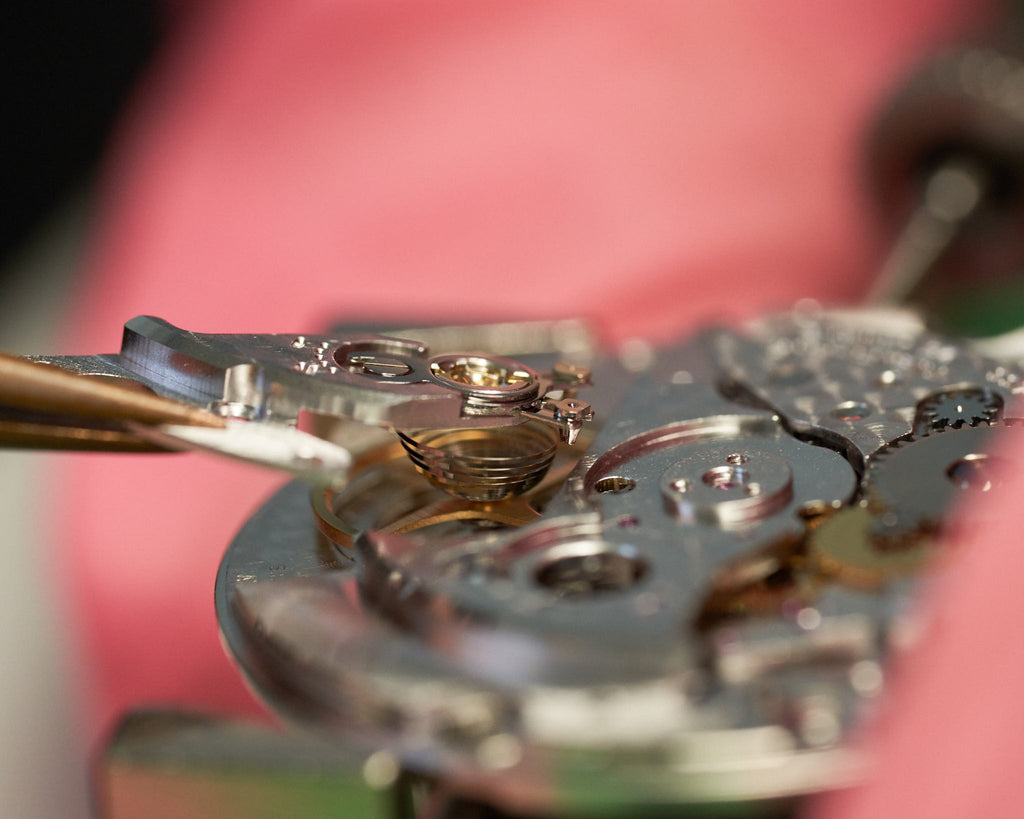What’s a Full Watch Service: Part 3, Assembly & Lubrication

Assembly is the part of the process that everyone pictures when they think “watch service.” As you can see, it’s just one link in the chain, but of course without it, you’re just left with a pile of really clean parts. Let’s get to it.
Regardless of the movement, assembly typically follows a similar pattern. First, the setting mechanism is installed and lubricated, then the base movement is assembled and oiled, then a pause for timing tests. Once the base movement passes initial timing tests, the rest of the complications (if applicable) can be assembled and the watch is ready for casing.

“Base movement” refers to the winding/setting/timing portions of the watch. On a Sellita SW300, that means everything but the automatic and the calendar mechanism. On the Eterna 3916M, it’s the entire lower module, minus the calendar. Complications are anything besides basic time-telling functionality, including the calendar, GMT mechanism or chronograph.
We test for timing at the base movement level because it saves time if there’s a problem. Complications take time to assemble, so if there’s a problem with the service it will show up in the initial tests before any time is wasted on assembling additional components. You can’t really “go backwards” in a watch service—once something is oiled and assembled, it has to be fully disassembled and re-cleaned if there’s a problem.

Assembly can be guided by a technical guide or a full step-by-step assembly guide. Tech guides show an exploded view and leave it to the watchmaker to figure out. Assembly guides spell out the individual steps, which can be especially helpful for complicated designs.
Both use a similar symbolic system for lubrication, with a series of arrows pointing to the oiling points. Greases will have a solid red arrow, with lighter greases sprouting a solid circle on top. Oils have hollow arrows, with more and more circles to denote lighter and lighter oils. Escapement greases are a hollow triangular arrow. Each calibre will have its own “key” to denote which oils to use for each arrow, but the pattern of arrows to mark the oil points is standardized across movement plans.
Oiling is done with a “dip oiler,” which is a just a fancy little spade-tipped needle with a handle. They come in a variety of sizes, and can be carefully bent for harder-to-access oiling points. Oil or grease is simply picked up on the spade by capillary attraction and wicked down into the pivot by the same force.

Greases are typically placed in points of high torque, especially if they’re metal-on-metal, like most parts in the setting mechanism or chronograph. Identical materials have a natural self-adhesion on the molecular level, so it’s important to keep a barrier of grease between them so everything stays free.
Oils are placed very carefully onto the pivots in their jewels. Oil must only go in the oil cup or on the crotch of the pivot shoulder, otherwise it will wick away. Oil on the flats of the jewel (or even on top of the pivot) can pull the oil right out of the cup, drying the pivot and stopping the watch, so any mistakes have to be perfectly cleaned.
Escapement grease is its own thing. Neither a heavy grease nor an oil, it has a thixotropic quality that cushions the impact of the escapement, while lubricating it smoothly during the sliding portions of the escapement action. Confused? It’s just like the cool non-newtonian goop you made in science class with corn starch and water. Firm like a solid when struck, but flows like a liquid when it moves slowly.

It is absolutely critically important to successfully oil every lubrication point. A single dry pivot or ungreased component will stop the watch. In watchmaking school, a solitary dry pivot was an immediate failure in an exam, no matter what. There’s no room for mistakes!
Once fully relubricated, the movement should be running back in manufacturer spec, and will stay that way for years. Modern oils eventually evaporate with time, so a service is required every 5-10 years to keep things fresh, but a proper service will have your watch ticking like it’s brand new!
Last up is casing and QC. Stay tuned for that chapter, coming next!
This is part 3 of a four part series about full service watch repair. Read the following parts here:
Think your